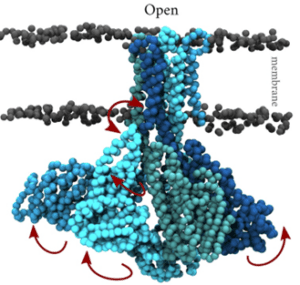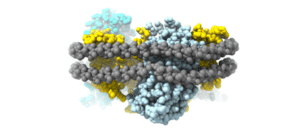Olga Chukhutsina is Assistant Professor at the Department of Physics at VU Amsterdam from November 2021. She leads her research line “‘Photoregulation in aquatic photosynthesis'” in the Biophysics of Photosynthesis group. Her goal is to study how different aquatic microorganisms respond to changes in light, from the organism to individual proteins. Olga studied Applied Physics in Minsk, Belarus, where she graduated with an MSc in 2010. In the same year, she moved to the Netherlands to pursue her PhD at Wageningen University with Herbert van Amerongen in the Biophysics Laboratory. She successfully defended her thesis ‘Light harvesting, light adaptation and photoprotection in aquatic photosynthesis studies by time-resolved fluorescence spectroscopy’ in 2015. Since her PhD, Olga has been interested in aquatic photosynthesis. The focus of her PhD was not on crystallography, but on advanced time-resolved spectroscopy to study photosynthesis and photoregulation of aquatic organisms at the whole organism level.

In 2015, Olga continued as a postdoctoral researcher at VU Amsterdam to advance the knowledge of photosynthesis and spectroscopy. She established advanced spectroscopic methods to study photosynthesis in whole plant leaves (Bag et al., 2020; Chukhutsina et al., 2019; Chukhutsina et al., 2020). Plant leaves are the most challenging spectroscopic samples due to their complicated morphology, high pigment concentration and high scattering. Spectroscopic measurements on single cells are much easier!
At the same time, Olga continued to contribute with her knowledge on photoregulation in aquatic photosynthesis (V. U. U. Chukhutsina et al., 2017; Van Den Berg et al., 2019). In early 2018, she moved to Imperial College (UK) to join the group in Jasper van Thor’s lab, first as an independent EMBO fellow and later as a Marie Curie fellow. This was her first project in crystallography. She began to study a fascinating protein involved in the photoregulation of aquatic photosynthesis, called the orange carotenoid protein (OCP). Her stay at Imperial College led to the first light-induced OCP structure (Chukhutsina et al., 2022). OCP is a very difficult protein to study because it has an extremely low photoconversion rate, so it is difficult to get measurable amounts of the photoconverted protein.
Currently Olga focusses her research on the photocycle of the OCP and its potential applications in environmental engineering. By gaining control over the photocycle of OCP, she believes it is possible to regulate the aquatic biomass of microorganisms. This could have significant implications for ecological management, particularly in marine environments. Primarily her work centers on photosynthesis and photoregulation in cyanobacteria and brown algae, which are key contributors to aquatic biomass. These organisms thrive in extreme conditions, and Olga is investigating their behavior in vivo through advanced spectroscopic methods. Her goal is to understand how they manage light and stress, which in turn influences their growth and survival. Another exciting area of Olga’s research centers on special algae known as dinoflagellates, which live in symbiosis with corals. These algae play a crucial role in coral health, as corals rely on the high-energy metabolites, like sugars, produced by dinoflagellates. When these algae are exposed to stressors such as high temperatures, excessive light, or increased acidity, coral bleaching can occur, which poses a major threat to coral reefs and the biodiversity they support. As coral reefs account for 25% of oceanic biodiversity, understanding the relationship between algae and corals is critical to conservation efforts.
To delve deeper into the mechanics of OCP and its role in photoregulation, Olga combines advanced spectroscopy with structural biology. She frequently utilizes cutting-edge serial crystallography techniques at world-renowned facilities such as the Diamond Light Source, LCLS, MAX IV, and SwissFEL. These methods enable her to explore the structural dynamics of OCP in great detail, with the hope of uncovering mechanisms that could be leveraged to optimize photosynthesis. A unique aspect of Olga’s research is her synergetic approach, which always connects structural changes observed in the lab back to the larger biological context. She grows and studies photosynthetic organisms in her lab while also examining the behavior of isolated protein crystals, providing a comprehensive view of how these processes function in nature.

Looking ahead, Olga plans to continue using these advanced crystallographic approaches to study other key photosynthetic regulators that are activated by light or pH changes. Her ultimate aim is to understand how these proteins control photoregulation on a molecular level.
In 2023 Olga got Unesco Loreal Women in Science Prize and was a NIAS (Netherlands Institute for Advanced Science) fellow 2023-2024. Olga will organize a workshop in June 2025 on the ‘Effect of Temperature on Photosynthesis’ – NVK will report on this and let you know.
Currently there is a postdoc opening in her group, get in touch via v.u.chukhutsina@vu.nl
References:
Bag, P., Chukhutsina, V., Zhang, Z., Paul, S., Ivanov, A. G., Shutova, T., … Jansson, S. (2020). Direct energy transfer from photosystem II to photosystem I confers winter sustainability in Scots Pine. Nature Communications, 11(1), 1–13. https://doi.org/10.1038/s41467-020-20137-9
Chukhutsina, V. U. U., Fristedt, R., Morosinotto, T., & Croce, R. (2017). Photoprotection strategies of the alga Nannochloropsis gaditana. Biochim Biophys Acta, 1858(7), 544–552. https://doi.org/10.1016/j.bbabio.2017.05.003
Chukhutsina, V. U. V. U., Holzwarth, A. R. A. R., & Croce, R. (2019). Time-resolved fluorescence measurements on leaves: principles and recent developments. Photosynthesis Research, 140(3), 355–369. https://doi.org/10.1007/s11120-018-0607-8
Chukhutsina, V U, Baxter, J. M., Fadini, A., Morgan, R. M., Pope, M. A., Maghlaoui, K., … van Thor, J. J. (2022). Light activation of Orange Carotenoid Protein reveals bicycle-pedal single-bond isomerization. Nat Commun, 13, 6420. Retrieved from http://biorxiv.org/content/early/2022/09/05/2022.01.17.475858.abstract
Chukhutsina, Volha U., Liu, X., Xu, P., & Croce, R. (2020). Light-harvesting complex II is an antenna of photosystem I in dark-adapted plants. Nature Plants, 6(7), 860–868. https://doi.org/10.1038/s41477-020-0693-4
Van Den Berg, T. E., Chukhutsina, V. U., Van Amerongen, H., Croce, R., & Van Oort, B. (2019). Light acclimation of the colonial green alga botryococcus braunii strain showa. Plant Physiology, 179(3). https://doi.org/10.1104/pp.18.01499
Written by Sven Hennig




